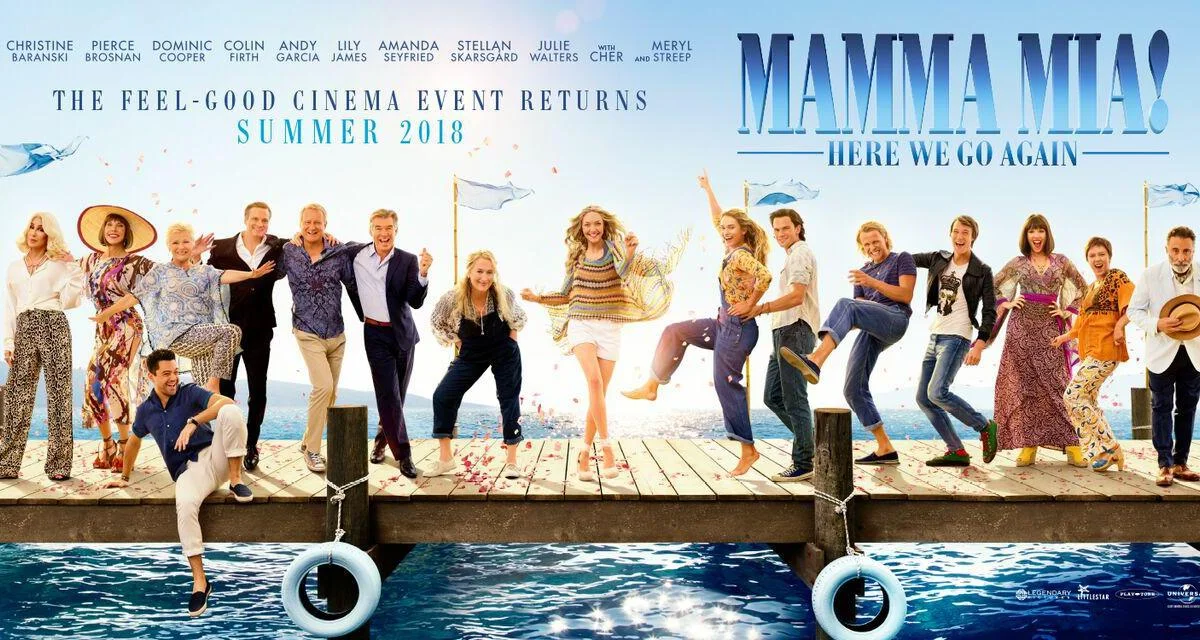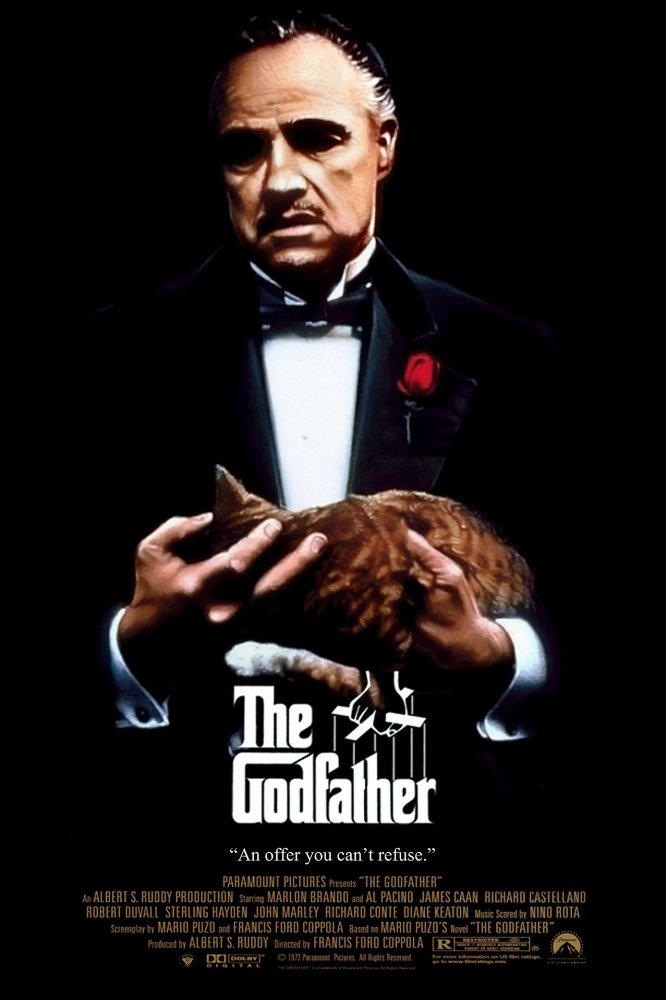Mamma Mia! Series (2008 & 2018)
Mamma Mia! was a hit Broadway musical featuring the music of Swedish musical group ABBA. In 2008 a film version of the hit show was released theatrically. It became a Summer box office smash hit over night. A decade later, Mamma Mia: Here We Go Again! (2018), a sequel to the first hit film, sometimes called: Mamma Mia! 2, was released. Below are the reviews for the two films.
Mamma Mia! (2008)
C – 108m
Aspect Ratio: 2.39:1 – Widescreen
A.K.A.: Mamma Mia! The Movie
Dir.: Phyllida Lloyd
Writer (Music Book and Script): Catherine Johnson
Exec. Pro.: Tom Hanks, Bjorn Ulvaeus and Rita Wilson
Music by: Benny Andersson and Bjorn Ulvaeus
Starring: Meryl Streep, Pierce Brosnan, Amanda Seyfried, Stellan Skarsgard, Colin Firth, Julie Walters, Christine Baranski, Dominic Cooper, Heather Emmanuel, Benny Andersson and Bjorn Ulvaeus.
A bride to be tries to find her real father; featuring the songs of the hit 1970’s group ABBA. Arguably the feel good movie of 2008! The film was a box office smash and it is easy to see why. Streep, Seyfried and the rest of the cast are in fine form and the music is fun. Note: Notice the music swells when Brosnan sings.
Trivia:
Pierce Brosnan signed onto the film knowing only that Meryl Streep was set to star and that it would be filmed in Greece. The cast members performed their own singing. Streep recorded the vocals for her rendition of, “The Winner Takes It All,” in one take. The, “Slipping Through My Fingers,” song scene features Meryl Streep and Amanda Seyfried laughing in a short clip. The crew blasted heavy metal music to get that footage. At the start of, ‘Dancing Queen,” the mirror next to Streep’s bed features Seyfried’s professional head shot and at the end of, “Our Last Summer,” Streep is holding a real baby picture of Seyfried. Several scenes such as “I Have A Dream,” were shot during the day but changed to evening or night in post–production. Cher was originally offered the role of Tanya but turned it down. She would go on to be in the sequel film: Mamma Mia!: Here We Go Again (2018). And: The Colin Firth line, “I’m Bright, Harry Bright,” is a spoof of the, “Bond, James Bond,” line in the 007 films; hence his delivery of it next to Pierce Brosnan.
Golden Globe nominee for: Best Motion Picture – Comedy Or Musical and Best Actress – Motion Picture – Comedy Or Musical – Meryl Streep.
Followed by: Mamma Mia!: Here We Go Again (2018).
Rated: [PG–13] – Some Sex Related Comments
Available on 4K & Regular Blu–ray, DVD & Digital Copy
Mamma Mia!: Here We Go Again (2018)
C – 114m
Aspect Ratio: 2.39:1 – Widescreen
A.K.A.: Mamma Mia! 2
Idea Originally Conceived By: Judy Craymer
Based On The Music By: Catherine Johnson
Story By: Richard Curtis, Ol Parker and Catherine Johnson
Screenplay By: Ol Parker
Exec. Prod.s: Benny Andersson, Richard Curtis, Tom Hanks and Bjorn Ulvaeus
Dir.: Ol Parker
Starring: Lily James, Amanda Seyfried, Meryl Streep, Dominic Cooper, Pierce Brosnan, Stellan Skarsgard, Christine Baranski, Colin Firth, Cher, Julie Walters, Jeremy Irvine, Andy Garcia, Josh Dylan, Hugh Skinner, Jessica Keenan Wynn, Alexa Davies and Bjorn Ulvaeus.
Music By: Benny Andersson, Anne Dudley and Bjorn Ulvaeus
Sophie learns about her mother’s past while pregnant herself. This was a step down from the mega hit a decade earlier. It is contrived to say the least and it shows in the “story” of the film. However the songs are fun, the cast is fantastic and the visual and audio aesthetics are perfect. So why complain too much. The stronger acting is done by the now seasoned actors: Streep, Seyfried, Brosnan, Skarsgard, Firth, Baranski, Walters, Garcia, Cher and Cooper, but the actors playing the younger versions of Streep, Brosnan, Skarsgard, Baranski, Firth and Walters show great promise. Pierce Brosnan performs a particularly touching scene in the film when he quietly warbles S.O.S. while looking at a picture of the younger Streep character. This may not be the caliber of the first one, and at that may still be of little to no interest of some people, but if given a chance, there is still a spark of warmth to it that a lot of films, released around the time of this one, don’t have. For that reason alone, it is worth watching.
Trivia:
This film was released exactly 10 years after the first one. Meryl Streep (Donna in this film series) filmed all her scenes in one week. Julie Walters was given a day off from the Shepperton Studios filming in November 2017 so she could attend an investiture ceremony at Buckingham Palace, where she was made a Dame Commander Of The Order Of The British Empire by Queen Elizabeth II. Cher, who played Meryl Streep’s mother and Amanda Seyfried’s grandmother in this film, was actually only 3 years older than Meryl Streep. ABBA member, Bjorn Ulvaeus, makes a cameo during the number: “When I kissed The Teacher”. ABBA member Benny Andersson appears as a University Chancellor during young Donna’s graduation. Cher was originally offered the role of Tanya in the first film but turned it down. A decade later she took a role in this film. Cher also handpicked Andy Garcia to play Fernando out of a bunch of selected actors. The film choreographer is the same choreographer who worked with the traveling Mamma Mia! North American Farewell Tour. The reveal of Bill Anderson’s twin was referenced in the first film with the line: “You’re not going to tell me you have a twin sister, are you?”
Rated: [PG–13] – Some Suggestive Material
Available on 4K & Regular Blu–ray, DVD & Digital Copy



























